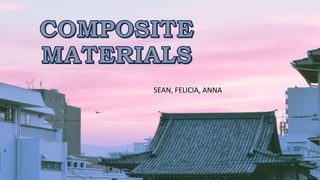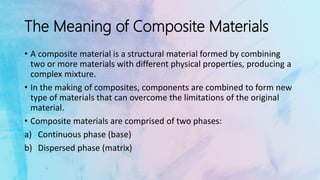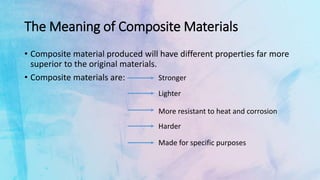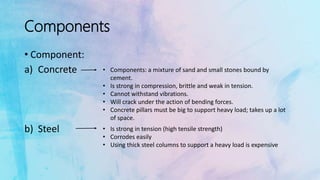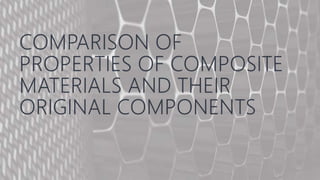Composite materials
- 2. The Meaning of Composite Materials âĒ A composite material is a structural material formed by combining two or more materials with different physical properties, producing a complex mixture. âĒ In the making of composites, components are combined to form new type of materials that can overcome the limitations of the original material. âĒ Composite materials are comprised of two phases: a) Continuous phase (base) b) Dispersed phase (matrix)
- 3. âĒ Composite material produced will have different properties far more superior to the original materials. âĒ Composite materials are: The Meaning of Composite Materials Harder Lighter Stronger More resistant to heat and corrosion Made for specific purposes
- 4. Components âĒ Component: a) Concrete b) Steel âĒ Is strong in tension (high tensile strength) âĒ Corrodes easily âĒ Using thick steel columns to support a heavy load is expensive âĒ Components: a mixture of sand and small stones bound by cement. âĒ Is strong in compression, brittle and weak in tension. âĒ Cannot withstand vibrations. âĒ Will crack under the action of bending forces. âĒ Concrete pillars must be big to support heavy load; takes up a lot of space.
- 5. Reinforced Concrete âĒ Reinforced concrete is made by adding the concrete mixture of cement, water, sand, chips and small stones into a frame of steel bars or steel wire netting. When set, a composite material is formed.
- 6. Reinforced Concrete âĒ Reinforced concrete is a stronger building material as it combines the compressive strength of concrete and tensile strength of steel. âĒ It does not corrode easily. âĒ It is relatively cheap. âĒ Can be molded into any shape. âĒ Can withstand very high applied forces (high pressure) and can support very heavy loads.
- 7. Uses of Reinforced Concrete âĒ Framework for highways âĒ Bridges âĒ Oil platforms âĒ High-rise buildings âĒ Dams
- 9. âĒ Existance of resistance causes the loss of electrical energy as heat âĒ Resistance increases as temperature increases. âĒ Can conduct electricity with zero resistance when they are cooled to extremely cold temperatures. (transition temperature- using liquid helium) âĒ it conducts electricity without any loss of energy
- 10. âĒ Ex. When Copper (II) oxide (CuO), barium oxide (BaO) & yttrium oxide (YâOâ) is heated up, a type of ceramic with the formula (YBAâCuâOâ), is produced ,known as perovskite / YBCO, which can attain superconductivity at 90K(-183°c) âĒ Metal oxides are electric insulators, however when combined to form a composite, it is a superconductor that can conduct very high current over long distance without any loss of energy. âĒ Used to make more efficient generators, transformers, electric cables, amplifier, computer parts, stronger & lighter electromagnets.
- 12. âĒ Bundles of glass tubes with very small diameter, finer than human hair & are very flexible âĒ Composite material that can transmit electronic data/signals, voices & images in a digital format, in the form of light along the fibre glass tubes at a fast speed âĒ Consists of a core of glass of higher refractive index enclosed by a glass cladding of lower refractive index. A light wave entering the fibre will travel along the glass tube due to total internal reflection.
- 13. âĒ In the field of telecommunication, 1. Used to replace copper wire in long distance telephone lines, mobile phones, videos, cameras and etc. 2. Carry more data (higher transmission capacity) with less interference 3. Higher chemical ability 4. Lower material cost 5. Can send signals faster than metal cables 6. Occupies less space
- 14. âĒ In the field of medicine 1. Laser beam can be chanelled through the fibre optics in operations to remove unwanted tissues 2. Used in endoscopes(used to examine the internal organs) âĒ Used in instruments 1. To inspect the interior of manufactured products.
- 15. âĒ Fibre glass is obtained by adding a polyester resin (a type of plastic) to molten glass. It cannot be compressed easily and is more tensile than the original materials. âĒ Fibre glass is light, withstands corrosion, can be cast into different shapes, is impervious to water, not very flammable, not brittle and stronger than even steel. âĒ It is used to make racquets, construction panels, electrical appliances, pipes, and water tanks.
- 17. âĒ Produced by embedding photochromic substances like silver halides in glass and adding a little copper (i) chloride âĒ When exposed to UV rays, silver halides decomposes to form silver and halogen atoms âĒ The silver deposited darkens the glass âĒ The photochromic glass become clear again when light intensity is lowered 2AgBr 2Ag+Brâ
- 18. âĒ Silver atom and bromine gas recombine by reacting with copper ion âĒ Used for making camera lens, car windshields, and information display panels
- 19. THE END

